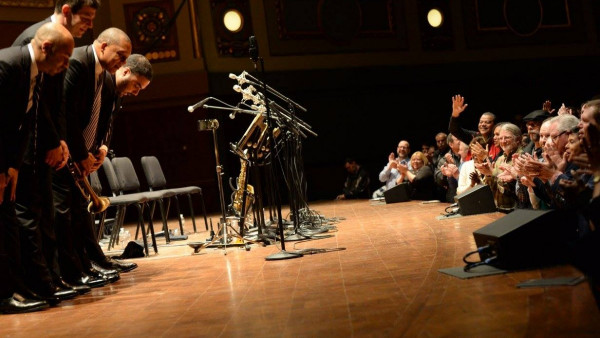Radical ideas reap rewards as CSO, Jazz at Lincoln Center mingle
What happens when two great orchestras — one jazz, one classical — share a stage and a score?
Previously unencountered sounds can occur, as they did in abundance Friday night in Orchestra Hall at Symphony Center, where the Jazz at Lincoln Center Orchestra and the Chicago Symphony Orchestra appeared en masse.
In some ways, the concert’s focal point — a bold reworking of Mussorgsky’s “Pictures at an Exhibition” — recalled two jazz-meets-the-classics experiments by Duke Ellington and Billy Strayhorn: “Nutcracker Suite” (inspired by Tchaikovsky’s original) and “Peer Gynt Suites” (drawn from music of Grieg).
But the world premiere of the new “Pictures,” its jazz portions commissioned by the Chicago Symphony Orchestra Association, proved more radical than either of those compositions, which fundamentally are jazz-swing versions of portions of familiar classical works. The JLCO/CSO “Pictures” took a different and more ambitious tack, the musicians playing Mussorgsky’s tone poem from start to finish — some movements featuring the CSO in Ravel’s famous orchestration of Mussorgsky’s original piano suite, others spotlighting the JLCO in arrangements by some of its members.
If you used your imagination — or simply indulged the conceit of this endeavor — this “Pictures” piece sounded as if Mussorgsky had composed a series of vignettes drawing upon both Russian symphonic and American jazz and blues traditions. Considering that Mussorgsky died in 1881 in St. Petersburg, that would not have been very likely.
Yet art can achieve what corporeal existence cannot. So listeners continuously bounded from 19th-century Russia to 20th- and 21st-century America, Mussorgsky’s famous themes serving as the connective tissue.
Remarkably, the end result was not a perpetual lurching between four-square classical rhythm and its jazz-swing counterpart but something that sounded nearly through-composed. It wasn’t hard to accept, in other words, that Mussorgsky’s musical ideas could be equally compelling in classical and jazz vocabularies. Perhaps that’s because the vivid colors of the Ravel orchestration and the intensely emotional, profoundly Russian character of Mussorgsky’s opus are quite naturally expressed in jazz, a music that communicates with similar fervors.
But considerable credit goes to the JLCO musicians who composed the new arrangements of particular movements of “Pictures,” capturing both the spirit of the Mussorgsky-Ravel score and the sonic possibilities that jazz alone provides.
The CSO’s eloquent delivery of the curtain-raising “Promenade,” under the sensitive direction of guest conductor Edwin Outwater, led into its reading of the “Gnomus” movement, but with a difference: The JLCO’s blues-tinged trumpets signaled that this was going to be a rather unorthodox “Pictures.”
“The Old Castle” section expanded on the point, JLCO reedist Victor Goines’ arrangement — or should we say rearrangement? — taking listeners to the beating heart of old New Orleans (Goines’ hometown). Goines’ lamenting clarinet phrases — so evocative of Crescent City master Sidney Bechet — and the sound of so many horns crying out at once affirmed that this was no gimmick. These musicians were playing hardcore jazz, albeit of an early vintage, Mussorgsky’s themes but a vehicle for their thoughts.
Perhaps the most striking segue between the two worlds of sound occurred in the “Tuileries” movement, the CSO opening with a light touch and transparent textures, the JLCO responding via bristling dialogues between brass and reeds in the Ellington manner (in an arrangement by JLCO trombonist Vincent Gardner). Here was incontestable evidence that the two ensembles, and the two musical languages they represent, could create a natural flow of sound rather than sharp contrast alone.
The hard-charging brass, streaks of dissonance and layered melodies that JLCO trombonist Chris Crenshaw penned for “The Hut on Hen’s Legs (Baba-Yaga)” evoked 1950s jazz modernism of the Stan Kenton variety. And the back-and-forth between the two orchestras in “The Great Gate of Kiev,” with New Orleans funeral-style march passages for the JLCO penned by ensemble trumpeter Marcus Printup, gave the piece its most galvanic series of climaxes.
And yet the venture missed a valuable opportunity, the closing pages played by the CSO, while JLCO members sat listening, watching and admiring. How much more thrilling and appropriate it would have been to have both ensembles playing the finale together in one exultant burst of sound. If this “Pictures” will be performed in the future — and one hopes it will — the final measures need to be rewritten to embrace all the musicians.
The program also featured the CSO performing a brisk account of Glinka’s Overture to “Ruslan and Ludmila” and atmospheric renditions of three sections from Ellington’s “The River.” The two orchestras joined forces for the “All-American Pep” movement of the “Swing” Symphony by JLCO music director and trumpeter Wynton Marsalis. Predicated on 1920s Charleston dance rhythm and showing the influence of Gershwin’s “An American in Paris,” “All-American Pep” became a bit blustery in its finale but made compelling points in its lyrical middle section, which contained some of Marsalis’ most inspired melodic writing.
An encore performance of Ellington’s “C-Jam Blues” enabled CSO bassist Robert Kassinger and others to riff alongside the JLCO at a surprisingly laid-back tempo.
But it was the Mussorgsky that represented the concert’s greatest risk and provided its deepest rewards.
by Howard Reich
Source: Chicago Tribune

